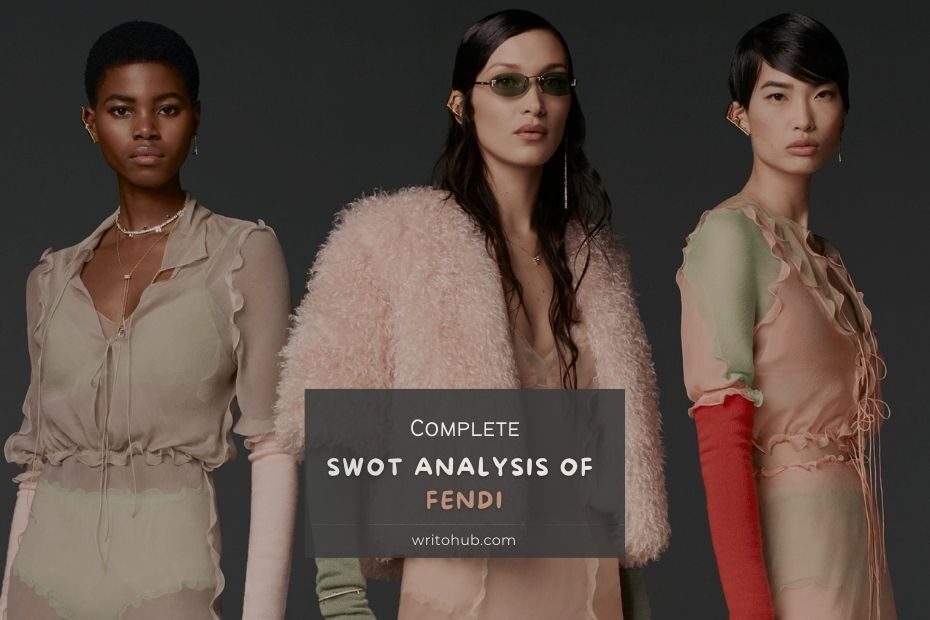Fendi, founded in 1925, is a renowned Italian luxury fashion brand known for its high-quality craftsmanship and sophisticated designs.
Conducting a SWOT analysis of Fendi allows us to assess its internal strengths and weaknesses, as well as external opportunities and threats.
This analysis provides insights into Fendi’s current market position and helps identify strategic areas for growth and improvement.
Strengths in the SWOT Analysis of Fendi
- Strong Brand Heritage: Fendi has a rich history and a strong brand heritage, known for its elegance, craftsmanship, and attention to detail. The brand’s long-standing reputation contributes to its desirability and consumer perception.
- Iconic Product Offerings: Fendi offers a range of iconic products, including luxury handbags, accessories, ready-to-wear clothing, and footwear. The brand’s distinctive design elements, such as the double “F” logo and fur detailing, set it apart and resonate with luxury fashion consumers.
- Creative Collaboration: Fendi has successfully collaborated with renowned designers, artists, and celebrities, creating limited-edition collections and attracting a broader consumer base. Collaborations bring fresh perspectives, generate buzz, and enhance Fendi’s brand image.
- Global Retail Presence: Fendi has a strong retail presence with boutiques located in major fashion capitals and luxury shopping destinations worldwide. This global footprint allows the brand to cater to affluent consumers across different regions and tap into international markets.
- LVMH Group: Fendi benefits from being a part of the LVMH Moët Hennessy Louis Vuitton conglomerate, which provides access to resources, expertise, and distribution networks. The association with LVMH strengthens Fendi’s position in the luxury fashion industry.
Weaknesses in the SWOT Analysis of Fendi
- Limited Product Diversification: Fendi’s product offerings primarily focus on luxury accessories and ready-to-wear clothing. Limited diversification beyond these categories may constrain revenue growth and limit the brand’s exposure to different consumer preferences.
- High Price Point: Fendi’s luxury positioning and high-quality craftsmanship result in premium pricing. While this positions the brand as exclusive and desirable, it may limit accessibility to a broader consumer base and make Fendi vulnerable to economic downturns.
Opportunities in the SWOT Analysis of Fendi
- Digital Transformation: Embracing digital technologies and expanding e-commerce capabilities can enhance Fendi’s online presence and reach a wider audience. Investing in immersive online experiences, personalized shopping, and digital marketing initiatives can drive growth in the digital era.
- Asian Market Expansion: The Asian luxury market, particularly China, presents significant growth opportunities for luxury brands. Fendi can tailor its marketing strategies, product offerings, and retail experiences to cater to the preferences of Asian consumers and further expand in this lucrative market.
- Sustainable and Ethical Practices: The demand for sustainable and ethically produced fashion is growing. Fendi can integrate sustainability into its supply chain, sourcing practices, and materials to appeal to environmentally-conscious consumers and align with changing industry expectations.
- Collaborations and Limited Editions: Continued collaborations with influential designers, artists, and celebrities can fuel excitement, attract new customers, and generate media attention. Limited-edition collections can create a sense of exclusivity and drive sales.
Threats in the SWOT Analysis of Fendi
- Intense Competition: The luxury fashion industry is highly competitive, with established brands and emerging designers vying for consumer attention. Competitors’ innovative designs, marketing strategies, and brand positioning pose a threat to Fendi’s market share and desirability.
- Counterfeit Products: Fendi’s brand recognition makes it susceptible to counterfeit products in the market. Counterfeits not only erode brand value but also compromise product quality and customer trust.
- Economic Volatility: Luxury brands are vulnerable to economic downturns and fluctuations in consumer spending. Economic uncertainties can impact consumer purchasing power, leading to reduced demand for luxury goods.
Conclusion
The SWOT analysis of Fendi highlights its strengths, weaknesses, opportunities, and threats in the competitive luxury fashion industry.
Fendi’s strong brand heritage, iconic product offerings, creative collaborations, global retail presence, and affiliation with the LVMH Group position it as a prominent luxury brand.
Addressing weaknesses related to product diversification and high price points is crucial for sustained growth. Seizing opportunities in digital transformation, Asian market expansion, sustainability practices, and collaborations can drive Fendi’s success in the evolving luxury fashion landscape.
Mitigating threats from intense competition, counterfeit products, and economic volatility requires strategic planning, brand protection measures, and continuous innovation.
By leveraging its strengths, addressing weaknesses, capitalizing on opportunities, and navigating threats, Fendi can maintain its position as a distinguished luxury fashion brand, offering discerning consumers exquisite craftsmanship, timeless style, and a sense of exclusivity.
